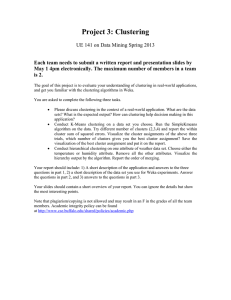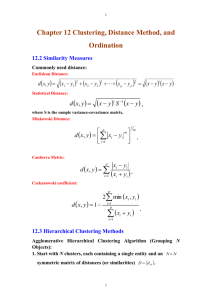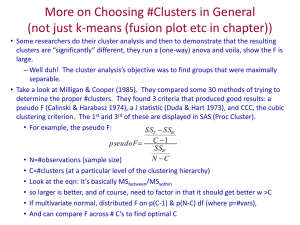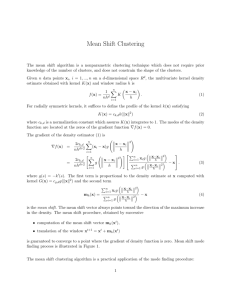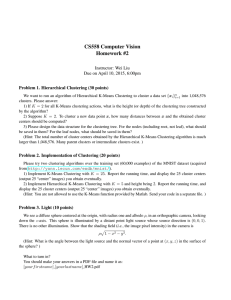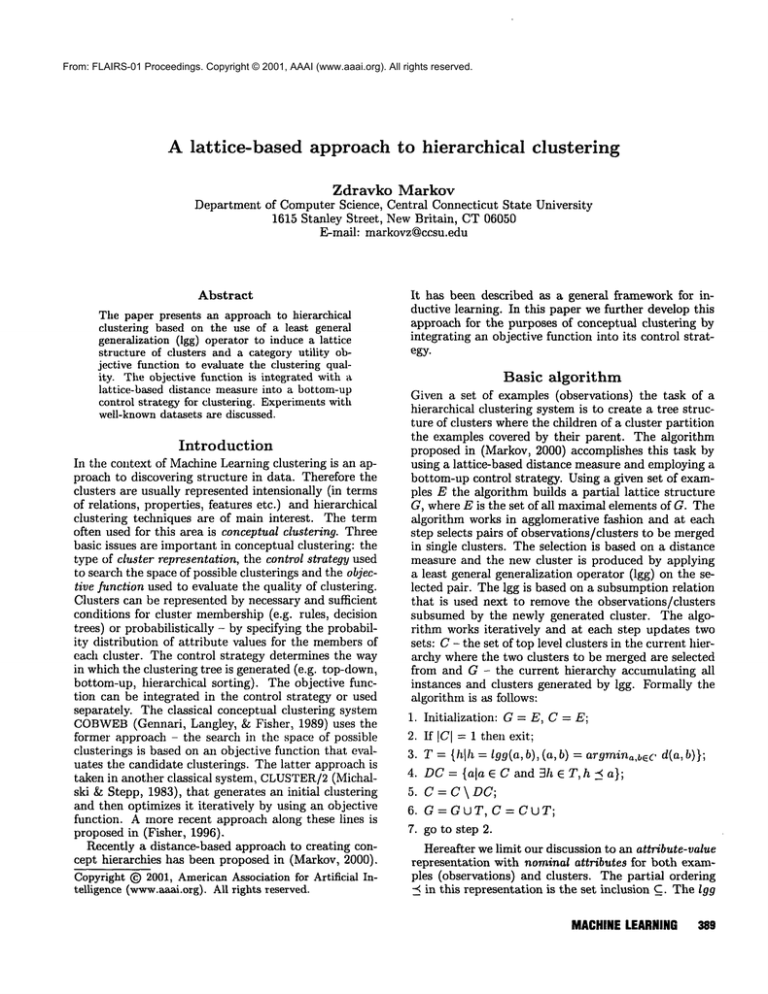
From: FLAIRS-01 Proceedings. Copyright © 2001, AAAI (www.aaai.org). All rights reserved.
A lattice-based
approach to hierarchical
clustering
Zdravko
Markov
Department of Computer Science, Central Connecticut State University
1615 Stanley Street, NewBritain, CT06050
E-mall: markovz@ccsu.edu
Abstract
The paper presents an approach to hierarchical
clustering based on the use of a least general
generalization (lgg) operator to induce a lattice
structure of clusters and a category utility objective function to evaluate the clustering quality. The objective function is integrated with a
lattice-based distance measure into a bottom-up
control strategy for clustering. Experimentswith
well-knowndatasets are discussed.
Introduction
In the context of MachineLearning clustering is an approach to discovering structure in data. Therefore the
clusters are usually represented intensionally (in terms
of relations, properties, features etc.) and hierarchical
clustering techniques are of main interest. The term
often used for this area is conceptual clustering. Three
basic issues are important in conceptual clustering: the
type of cluster representation, the control strategy used
to search the space of possible clusterings and the objective f~mction used to evaluate the quality of clustering.
Clusters can be represented by necessary and sufficient
conditions for cluster membership(e.g. rules, decision
trees) or probabilistically - by specifying the probability distribution of attribute values for the membersof
each cluster. The control strategy determines the way
in which the clustering tree is generated (e.g. top-down,
bottom-up, hierarchical sorting). The objective function can be integrated in the control strategy or used
separately. The classical conceptual clustering system
COBWEB
(Gennari, Langley, & Fisher, 1989) uses the
former approach - the search in the space of possible
clusterings is based on an objective function that evaluates ttm candidate clusterings. The latter approach is
taken in another classical system, CLUSTER/2
(Michalski &Stepp, 1983), that generates an initial clustering
and then optimizes it iteratively by using aa objective
function. A more recent approach along these lines is
proposed in (Fisher, 1996).
Recently a distance-based approach to creating concept hierarchies has been proposed in (Markov, 2000).
Copyright (~) 2001, AmericanAssociation for Artificial Intelligence (www.aaai.org).All rights reserved.
It has been described as a general framework for inductive learning. In this paper we further develop this
approach for the purposes of conceptual clustering by
integrating an objective function into its control strategy.
Basic algorithm
Given a set of examples (observations) the task of
hierarchical clustering system is to create a tree structure of clusters where the children of a cluster partition
the examples covered by their parent. The algorithm
proposed in (Markov, 2000) accomplishes this task
using a lattice-based distance measure and employing a
bottom-up control strategy. Using a given set of examples E the algorithm builds a partial lattice structure
G, where E is the set of all maximalelements of G. The
algorithm works in agglomerative fashion and at each
step selects pairs of observations/clusters to be merged
in single clusters. The selection is based on a distance
measure and the new cluster is produced by applying
a least general generalization operator (lgg) on the selected pair. The lgg is based on a subsumption relation
that is used next to remove the observations/clusters
subsumed by the newly generated cluster. The algorithm works iteratively
and at each step updates two
sets: C - the set of top level clusters in the current hierarchy where the two clusters to be merged are selected
from and G - the current hierarchy accumulating all
instances and clusters generated by lgg. Formally the
algorithm is as follows:
1.
2.
3.
4.
5.
6.
7.
Initialization:
G = E, C = E;
If ICI = 1 then exit;
T = {hlh = lgg(a, b), (a, b) = argmina,beCd(a, b)};
DC= {ala ¯ C and 3h ¯ T,h ~_ a};
C=C\DC;
G=GUT, C=CUT;
go to step 2.
Hereafter we limit our discussion to an attribute-value
representation with nominal attributes for both examples (observations) and clusters. The partial ordering
-~ in this representation is the set inclusion C. The lgg
MACHINELEARNING 389
(infimum) of two elements is defined as their intersection, i.e. lgg(a, b) = a nb. The distance function is
defined as d(a, b) = -c°vCa) +2-c°v(b} - 2 x 2-c°~(~nb),
where coy(a) is the number of examples covered by
i.e. coy(a) = I{b[b ¯ E,a -~ b}[.
Since in most cases the set T created in step 3 is not a
singleton, a restricted version of the algorithm is usually
used. The basic idea is instead of the whole set T to
use just a single element of T (arbitrarily chosen). This
1reduces the computational complexity of the algorithm
and also narrows the created hierarchy.
Weillustrate
the algorithm by a simple example of
hierarchical clustering of a set of 10 animals represented
by 6 attributes: covering, milk, homeothermic, habitat,
eggs and gills. Table 1 shows the initial set E and the
resulting set G. To display the examples/clusters we
use positional encoding, i.e. each element of the hierarchy is a list of values or underscores (denoting
missing attribute). In this representation the members
of a cluster h are all elements of G that h subsumes,
i.e. the elements that have the same values at the same
positions as h, where an underscore in h matches all
values. Obviously because of the random choice in step
3, the clusterings may differ from run to run. Figure
1 shows two possible hierarchies generated by the algorithm (the bottom hierarchy corresponds to the set G,
shownin Table 1). Weare further interested in the following questions: howcan we evaluate these hierarchies
and can we use this evaluation to improve the quality
of clustering. Wediscuss these questions in the next
section.
E
G
{feathers,f, t, land, t, f} {feathers,f, t, land, t, f}
{hair,t, t, air, f, f}
{hair,t, t, air, f, f}
{feathers,f, t, air, t, f}
{feathers,f, t, air, t, f}
{hair, t, t, land, f, f}
{hair, t, t, land, f, f}
{scales,f, f, land,t, f}
{scales,f, f, land, t, f}
{none,f, f, land, t, f}
{none,f, f, land, t, f}
{none,t, t, sea, f, f}
{none,t, t, sea, f, f}
{hair,t, t, sea, t, f}
{hair, t, t, sea, t, f}
{scales,f, f, sea, t, f}
{scales,f, f, sea, t, f}
{scales,f, f, sea, t, t}
{scales,f, f, sea, t, t}
{scales,
f, f, sea,t, _}
{_, f, f, land,t, f}
{_, f, f, _, t, _}
{hair, t, t, _, f, Q
{feathers,f, t, _, t, f}
{_,f,_,_,t, _}
{hair,t, t, _, _, f}
{_, t, t, _, _,f)
{-,-, -, _,_,-}
Table 1: Attribute-value representation of observations
and clusters for the "animals" example (t and f stand
for true and false respectively)
Evaluating clustering quality
[ scales,f,f,sea,t,t }-F
A commonlyused measure to evaluate clustering quality is the category utility function proposed in (Gluck
& Corter, 1985). This is the objective function used in
COBWEB
(Gennari et al., 1989) and in many related
systems. Category utility attempts to maximize both
the probability that two objects in the same category
have attribute values in commonand the probability
that objects from different categories have different attribute values. The category utility function assigns a
value CU(Ck)to each cluster Ck as follows:
CU(Ck) = E [P(Ai =VijlCk)2 -P (Ai = 2]
V~j)
i j
The sums are calculated for all attributes Ai and all
their values Vii. The probabilities P(Ai = Vi~lCk) and
P(AI = V~j) are calculated as relative frequencies of the
occurrence of the V~j value for the Ai attribute within
the cluster Ck and within the whole set of observations
respectively.
CU(C~)estimates the quality of individual clusters.
To measure the quality of a clustering we need a function that evaluates the quality of a partition of data.
1Thecomplexity of the algorithm in this case is O(n3),
where n = IEI. More details on this issue can be found in
(Markov, 2000).
39O
FLAIRS-2001
{ scales,f,f, sea, t,_ } -- { scales,f,f, sea,t,f } -R
_i
. / . .............................
.I " ....
{ ..... sea~_,_}
{ .........
f} ......
~,¯
{_,t,t,sea,_,f} ......
"{none,t,t,sea,f,f}-M
{ hair,t,t,_,f, fl ......
{ feathers,f,t,land,t,f) -B
{ feather~,f,t,air,t,f }-B
{_,f,f, land,t.f} " "
[ hair,t,t,sea,t,f )-M
{hair,t,t,air,f,fl-M
{ hair,t,t,land,f,fl-M
{ scales,f,f, land.t,f}-R
" { none,f,f,land,t.f }-A
Iscales,f,f,
sea.t,f
} -R
{w,alea,f,f,
sea,t~}--{scales,f,
Lsea,t,t)-F
{_,f,f,_J~J -- {~f,f, land,t,f~ -- |scalcs,f,f,|and.t,f}-R
[ f~,f,t, land,l,f} -B
[ none~
f, Lland,t,f}-A
{_,f~.t,.~l - Ifeathers,Lt~.t.f}
....
| feather,
f, kair.t,f }-B
{ ~,.-,-=)
[~t,t,~_,f}
I hair,t,t,air,f,f J -M
{hair,t,t,_,f,f}
...........
-- {hair,t,t~wf}
...
...
........ [ hair,t,Lland.f,f)-M
{ none,Lt,sea,f,f}-M{hair,t,t,sea,t,f)-M
Figure 1: Concept hierarchies
ple
for the "animals" exam-
For this purpose the average category utility of clusters
in the partition is used, i.e. PU({C1,C2,...,Cn}) =
cu(c
).
In hierarchical clustering the partition utility function
PU can be used at any level of the concept hierarchy.
Applied to the children of the root PU evaluates the
overall partition of the observations. For example the
PUscores for the top level partitions of the two concept
hierarchies in Figure 1 are as follows:
PU({{_, _, _, sea, _, _}, {_, _, _, _, _, f}}) = 0.191
PU({{_,f, _, _,t, _}, {_,t,t,_,_,f} }) = 0.612
These PU scores show that the second clustering is
better than the first one. This a/so becomes clear if
we look at the class memberships of the observations.
The classes that the observations belong to are shown
at the leaves of the hierarchies as M, B, R, F and A
(denoting mammal, bird, reptile, fish and amphibian
respectively). These labels are not used by the algorithm, however they may be used to evaluate "externally" the created hierarchy. For the bottom clustering, {_, t, t, _, _, f} represents the cluster of mammals,
and the other cluster - {_, f, _, _, t, _}, groups all nonmammals.The structure of {_, f,_,_, t, _} reflects the
natural way of grouping birds, reptiles, fish and amphibians. This observation is also supported by the
PU scores of the lower level partitions. For example,
ttle PUscores of the partitions of the mammalclusters
in the two hierarchies are:
PU({_,_, _, _, _, f}) = 0.374
PU({_,t, t, _, _, f}) = 0.421
Another reason for these scores is that the mammal
and non-mammalclusters in the first hierarchy overlap
(they share 3 observations) while in the second hierarchy they are completely disjoined.
The above considerations suggest that there is a kind
of propagation of "good" PU scores (i.e. good partitions of data) from the lower to the upper levels of
tile concept hierarchy. This in turn suggests a way to
integrate the PUscores as an objective function into
the control strategy of our basic algorithm described
in Section 2. This algorithm uses a bottom-up control
strategy. At each iteration a new cluster h is added to
the hierarchy. Since at this stage the whole partition at
that level of the hierarchy is still unknown,h should be
evaluated individually with respect to its contribution
to the quality of clustering for the partition in which
it will be included at a later step. That is, h has to
maximize its CUscore. To implement this we modify
step 4 of the basic algorithm accordingly:
4. h = argmaxheT CU(h), T {h }, DC= { al a 6
C,h ~ a};
An important issue in bottom-up clustering is how
to determine when to stop merging clusters.
In
our algorithm the newly generated cluster h replaces
the clusters/observations
that it subsumes. Since
the goal is to maximize the quality of clustering in
terms of PU scores, it is expected that CU(h)
PU({hl, h~,..., hn}), where hi, h2, ..., hn are the clusters/observations
that h subsumes, i.e. h --< hi,
i = 1,2,...,n.
This condition can be used to stop
the process of merging clusters and thus to cut off
the hierarchy at a certain level. For a greater cutoff, a stronger condition can be defined as CU(h)
max{CU(hl), CU(h2), ..., CU(h,)}). In fact, we introduce a cutoff parameter W6 [0, 1], that is used to
control this process by gradually switching between the
two conditions:
CU(h) > PU({hl,...,hn})
+ W*
(max{CU(hl), ..., CU(hn)} - PU({hl,..., h,,}).
The cutoff parameter Wis used in step 4 of the algorithm in the following way. If h satisfies the stopping
condition, then its successor with maximal CU score
is used as a top-level cluster (an immediate successor
of the root). This is achieved by excluding the latter
and all its successors from the candidates for further
merging.
Experiments
To evaluate the performance of the algorithm we conducted experiments with some well-known datasets.
They include the previously discussed "animals" data
containing 10 examples with 6 attributes,
the "zoo"
dataset - 59 examples with 16 attributes and the small
soybean dataset - 47 examples with 35 attributes,
all
obtained from the UCI MLrepository (Blake & Merz,
1998). The class attributes were removedfrom all three
datasets and after the concept hierarchies were generated the class information was used as an additional,
"external" criterion to evaluate the quality of clustering. The idea was that the top-level partition should
reflect the class distribution in the set of observations.
As a basis for comparison a version of ttle COBWEB
algorithm provided by the WEKA-3MLsystem (Witten & Frank, 1999) was used in the experiments. Table
2 shows the PUscores of the top level partition produced by two clustering algorithms - the lattice-based
clustering with gain function (denoted as LGG-PU)and
COBWEB
with the three data sets discussed above. Table 3 shows the performance of the same algorithms on
the same datasets measured by the entropy of the class
attribute in the clusters from tim top level partition.
The entropy of the class attribute in a cluster Ck is
calculated as follows:
H(Ck) = - ~ P(C = ~) log 2 P(C = 1~),
.i
where V/ are the values of the class attribute C, that
occur in the examples belonging to cluster Ck. Then the
entropy in a partition {Cl, C.,, ..., Ck}, or the partition
entropy PHis:
PH({Cl, C2, ...,
Cn})
~
~H(Ck),
k
where the terms C~l are weight coefficients
count for the cluster size.
ttmt ac-
MACHINELEARNING 391
LGG-PU
0.505
animals (10 obs, 6 attrs)
zoo(59obs,16attrs)
0.745
soybean
(47 obs,35attrs) 0.75
COBWEB
0.505
0.721
1.46
Table 2: PUscores for the top level partition
datasets
LGG-PU
animals (10 obs, 6 attrs)
0.27/4
zoo(59obs,16attrs)
1.03/7
soybean
(47 obs,35attrs) o/8
of three
COBWEB
0.27/4
0.99/4
o.4914
Table 3: PHscores/number of clusters for the top level
partition of three datasets
In the ideal case each cluster contains examples of a
single class and then the PHfunction of this partition
is 0. In the general case small PHscores mean that the
partition of the data corresponds to the distribution of
the class attribute. Of course this also depends on the
representativeness of the set of examples (i.e. whether
it contains a sufficient numberof instances from every
class).
A further experiment was conducted with the relational version of the basic algorithm. As described in
(Markov, 2000) this algorithm can handle relational
data by using a relational lgg. For our representation such lgg can be implemented by anti-unification.
This is an operation that replaces same constants with
same variables. For example Igg({a,b,a},{c,d,c})
{X, Y, X}, where X and Y are variables. The main advantage of this representation is the possibility to define
explicitly equality of attribute values. To investigate the
behavior of our clustering algorithms we used the training sample of the MONK1
dataset (Thrun et al., 1991).
This dataset describes a concept with 6 attributes by 61
positive and 61 negative examples. The propositional
description of the target concept is:
(octagon, octagon ........}
(square, square ........}
(round, round ........}
{ ........ red, _}
While the relational one is:
(x, x ........
}
{ ........ red, _}
Forclustering
we usedjustthepositive
examples.
The
whole set of examples (including the negatives) was
used for "external" evaluation of the top level clusters.
The experiments with the MONK1
data are summarized
in Table 4.
The main findings reflected in the experiments are
the following:
¯ For propositional
data the LGG-PUalgorithm performs similarly to COBWEB
as long as the PU scores
392
FLAIRS-2001
COBWEB
LGG-PU
PU
0.14
0.16
PH
0
0
#ofclusters
7
2
Table 4: Results of clustering the MONK1
data. The
PU and PH scores, and the number of clusters refer to
the top level partition. PH is calculated by using the
whole set of examples (positive and negative).
are concerned. In some cases LGG-PUachieves much
better PH scores than COBWEB.
A cutoff parameter
W close to 0 results in high PU scores and low PH
scores. With Wclose to 0, the PUscores are low and
the PH scores are high.
In the relational case both algorithms achieve 0 entropy at the top level partition.
LGG-PUhowever
built two clusters that matchexactly the original definition of target concept. COBWEB
created very fragmented definition obviously because it does not take
into account the relational similarity between observations.
In the relational example (MONK1)
the PU scores are
low for both algorithms. This is because the two top
level concepts in the original definition of the target
concept substantially overlap.
Related
work
Most of the approaches to hierarchical and conceptual
clustering are related to two classical systems - CLUSTER/2 (Michalski & Stepp, 1983) and COBWEB
(Gennari et al., 1989). CLUSTER/2
generates an initial clustering and then optimizes it iteratively by attempting
to minimizethe cluster overlapping. Clusters are represented as necessary and sufficient conditions for cluster
membership(e.g. rules) and are derived by a standard
concept learning algorithm. In COBWEB
the clusters
are represented probabilistically by the probability distribution of the attribute values for the membersof each
cluster. The control strategy used is based on the PU
function. There are manyother systems that follow the
COBWEB’s
approach. Some of them elaborate the objective function by using information-based heuristics
(e.g. the information gain used in decision tree induction), Bayesian variants of PU (used in AUTOCLASS
(Cheeseman, Kelly, Self, Stutz, Taylor, & Freeman,
1988)), or the Minimal Message Length (MML)principle (used in SNOB(Wallace & Dowe, 1994)). Others
combine the COBWEB
and the CLUSTER/2approaches
- they first generate initial clustering and then optimize
it by using various objective functions. The approach
taken in (Fisher, 1996) is based on this idea. It uses
hierarchical sorting to induce a clustering and then iteratively simplifies it by applying various techniques as
redistribution, reordering etc.
There is third approach to hierarchical clustering that
is based on lattice structures. The lattices are a useful
mathematical formalism that resembles cluster hierarchies. The problem with the use of lattices for clustering is that the techniques for generating clusters should
have some formal properties (usually not present in the
heuristic algorithms). The computational complexity
of the lattice algorithms is also high. Nevertheless lattice approaches to clustering exist and someof them are
successfill.
For example (Guenoche & Mechelen, 1993)
use Galois lattices to induce hierarchical clusterings for
binary attributes.
This approach is based on the socalled maximal rectangles and employs some standard
algorithms from Galois lattice theory.
Our approach is also based on lattices. Its theoretical basis is the distance measure introduced in (Markov,
2000) that allows to evaluate the similarity between examples/clusters as well as to apply consistently a generalization operation (lgg) to build the lattice structure. The use of a PU-based objective function allows
to improve the quality of clustering and to reduce the
complexity of the algorithm. The main features of the
approach can be summarized as follows:
¯ LGG-PU
represents clusters as propositional or relational rules. Similarly to CLUSTER/2
it allows cluster overlapping.
¯ It uses a PU-basedobjective function to evaluate the
quality of clustering.
¯ The control strategy of the algorithm is a bottomup greedy search based on a consistent integration
of a lattice-based distance measure and a PU-based
objective function.
¯ LGG-PU
is able to build relational descriptions of the
clusters. Although the PU function does not work
well on relational data, it is still useful in the control
strategy of the algorithm.
Conclusion
Wedescribed an approach to hierarchical clustering
based on the use of a least general generalization (lgg)
operator to induce a lattice structure of clusters and a
category utility objective function to evaluate the clustering quality. The objective function is integrated with
a lattice-based distance measure into a bottom-up control strategy for clustering. The preliminary experiments showed that the approach coinpares well with
other similar approaches and in some cases outperforms
them. The future work will address the following issues:
¯ Extending the algorithm to handle numeric attributes. This can be achieved by extending the partial ordering relation (presently set inclusion) and
defining a proper lgg that can generalize numeric attributes too. Then we can use the same distance
measure and a PUfunction that uses probability distributions.
¯ Although the algorithm evaluates clusters locally, it
also maximizesthe overall clustering quality since the
local evaluation goes through all levels of the hierarchy in a bottom-up fashion. Of course, as this is a
greedy search, there is no guarantee that the global
maximumcan be found. With this respect other approaches to evaluating the quality of clustering have
to be investigated too (e.g. the recursive ones used
in COBWEB).
References
Blake, C., & Merz, C. (1998). UCI repository of machine learning databases..
Cheeseman, P., Kelly, J., Self, M., Stutz, J., Taylor, W., & Freeman, D. (1988). AutoClass:
Bayesian classification
system. In Proceedings
of the Fifth International Workshop on Machine
Learning, Ann Arbor, pp. 54-64 San Mateo, CA.
Morgan Kanfmann.
Fisher, D. (1996). Iterative optimization and simplification of hierarchical clusterings. Journal of Artificial Intelligence Research,,~, 147-179.
Gennari, J. H., Langley, P., & Fisher, D. (1989). Models of incremental concept formation. Artificial
Intelligence, 40, 11-61.
Gluck, A., & Corter, J. (1985). Information, uncertainty, and the utility of categories. In Proceedings
o/the Seventh Annual Conference o/thr Cognitive
Science Society, pp. 283-287 Hillsdale. Lawrence
Erlbaum.
Guenoche, A., & Mechelen, I. V. (1993). Galois approach to the induction of concepts. In Mechelen, I. V., Hampton,J., Michalski, R., & Theuns,
P. (Eds.), Categories and Concepts: Theoretical
Views and Inductive Data Analysis, pp. 287-308.
Academic Press.
Markov, Z. (2000). An algebraic approach to inductive learning. In Proceedings o/ 13th International FLAIRS Conference, pp. 197-201 Orlando,
Florida, May 22-25. AAAIPress, Extended version in IJAIT, Vol 10, No.1-2, to appear in Marcia
2001.
Michalski, R., & Stepp, R. (1983). Learning from observation: conceptual clustering. In Michalski,
R., Carbonell, J., & Mitchell, T. (Eds.), Machine
Learning: Artificial Intelligence Approach, Vol. 1,
pp. 331-363. Tioga.
Thrun, S. B., et al. (1991). The MONK’sproblems
- a performauce comparison of different learning
algorithms. Tech. rep. CS-CMU-91-197,Carnegie
Mellon University.
Wallace, C., &Dowe,D. (1994). Intrinsic classification
by mml - the snob program. In Proceedings o/
the Seventh Australian Joint Conference on Artificial Intelligence, pp. 37-44 Armidale, Australia.
WorldScientific.
Witten, I., & Frank, E. (1999). Data Mining: Practical Machine Learning Tools and Techniques with
Java Implementations. Morgan Kaufmann.
MACHINELEARNING 393

